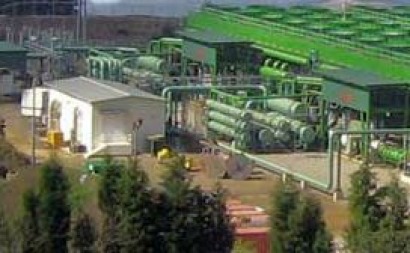
The winners were selected in categories including Technological Advancement, Economic Development and Environmental Stewardship.
Now in its third year, GEA also provides special recognition of companies and individuals who have made notable advances and achievements for geothermal energy.
"Even in a challenging environment, our GEA Honors winners represent the best in a growing industry. These geothermal leaders are trailblazers and should be praised for the headway they're achieving for the entire sector," said Geothermal Energy Association Executive Director Karl Gawell.
US Geothermal's 22 MW Neal Hot Springs Power Plant took the technical advancement prize. The facility, near Vale, Oregon, is considered the first commercial, supercritical Organic Rankine Cycle (ORC) binary power plant.
TAS Energy designed, manufactured and installed the supercritical ORC binary power plant employing R134a, an organic working fluid that is non-toxic and non-flammable.
GeothermEx was recognized for its role in economic development and its "substantial contribution to the development of local, regional or national markets through the development of geothermal systems."
According to the GEA, the company excels in the facilitation of common understanding between developers and financiers. To date, GeothermEx's evaluations have enabled the development of more than 7,000 MW of geothermal power, the total financed to date exceeding $12 billion.
Dale Merrick of Canby Geothermal received the Environmental Stewardship award, which was presented in conjunction with the Environmental and Energy Study Institute (EESI).
" Dale Merrick has been a leader and visionary working to implement a community-based geothermal development project at Canby , California," the GEA said in a written statement. "The project would produce power and cascade the remaining energy to support an existing geothermal district heating system and future greenhouse and aquaculture businesses.
"If successful, Canby would be the first net-zero community in California and a model to the 71 communities in the state identified by the CEC as having a co-located geothermal resource. Projects like the Canby Geothermal System take many different types of support, and an advocate and visionary, like Dale Merrick, is essential. Canby Geothermal is a classic example of what a geothermal 'champion' and a supportive community can do, the industry association said.
Several Special Recognition Awards were also presented.
The first went to Katherine Young and her team at the National Renewable Energy Laboratory in the US for their work on the Geothermal Regulatory Roadmapping effort.
Others similarly recognized were the Steamboat Hot Springs Healing Center in Reno, Nev.; Authors Magnus Gehringer and Victor Loksha of the World Bank for the ESMAP Geothermal Handbook; and Cornell Team Erin Riley Camp, Sean Hillson and Jeff Tester for their help on GEA's analysis efforts, particularly the Geothermal Externalities Paper (Promoting Geothermal Energy: Air Emissions Comparison and Externality Analysis).
For additional information:

